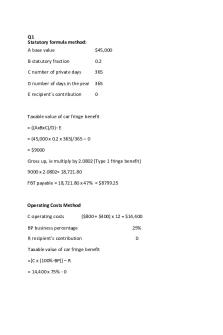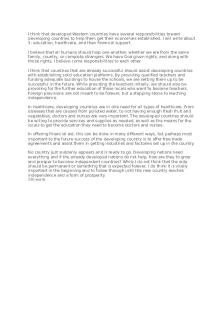TUT activities WK 8. pdf PDF

| Title | TUT activities WK 8. pdf |
|---|---|
| Author | Jake Hensley |
| Course | Social Psychology |
| Institution | University of New South Wales |
| Pages | 2 |
| File Size | 102.9 KB |
| File Type | |
| Total Downloads | 38 |
| Total Views | 142 |
Summary
tut activities for psychology UNSW its alright...
Description
Task 1: Structure of a Neuron On the worksheet select the correct labels for each part of the neuron below.
Glossary 1.Cell nucleus 2.Dendrites 3.Cell body 4.Neural impulse 5.Axon 6.Myelin Sheath 7.Axon terminals (AKA terminal buttons)
Task 2: Function of a Neuron The processes in an action potential can be complex, but to make things easier we can break it down into 5 key phases. Below these phases and their definitions have been mixed up. In the worksheet, match the label of the phase to the definition, and then number (from 15) the order in which they occur. 1. 2. 3. -
Stimulus Starts the rapid change in voltage or action potential. Depolarisation The sodium channels open, and sodium begins to enter the cell Repolarisation The sodium channels become refractory, and no more sodium can enter the cell. The potassium channel opens, and potassium begins to leave the cell. 4. Hyperpolarization - The potassium continues to leave the cell, and the membrane potential begins to return to the resting potential. The potassium channels eventually then close, and the sodium channels rest. 5. Resting state - The membrane potential returns to the baseline voltage that occurred before the stimulus occurred.
Task 3: The importance of a wrinkled cortex In up to 150 words, using the space provided in the worksheet document, explain why the cerebral cortex is wrinkled.
The cerebral cortex has wrinkles that increase the surface area for neurons. The reason brains are wrinkly is as a result of the rapid growth of the brain's outer brain, the gray matter is constrained by the white matter....
Similar Free PDFs

TUT activities WK 8. pdf
- 2 Pages

Tut wk 8 calculation outline
- 4 Pages

Week 8 Tut Qs.......
- 1 Pages

Week 8 Tut Answers.
- 3 Pages

FLCT Module 8 Activities
- 14 Pages

TUT 4 - TUT 4
- 2 Pages

Finance Tut 2 - Tut 2
- 1 Pages

Tut Topic 8 QA-new - good
- 11 Pages

WK 10 Pharm 2 PDF - LECTURE NOTES
- 29 Pages

Discussion forum wk 8 bus 2207
- 1 Pages

Listening Quiz 2 (wk 5-8)
- 1 Pages
Popular Institutions
- Tinajero National High School - Annex
- Politeknik Caltex Riau
- Yokohama City University
- SGT University
- University of Al-Qadisiyah
- Divine Word College of Vigan
- Techniek College Rotterdam
- Universidade de Santiago
- Universiti Teknologi MARA Cawangan Johor Kampus Pasir Gudang
- Poltekkes Kemenkes Yogyakarta
- Baguio City National High School
- Colegio san marcos
- preparatoria uno
- Centro de Bachillerato Tecnológico Industrial y de Servicios No. 107
- Dalian Maritime University
- Quang Trung Secondary School
- Colegio Tecnológico en Informática
- Corporación Regional de Educación Superior
- Grupo CEDVA
- Dar Al Uloom University
- Centro de Estudios Preuniversitarios de la Universidad Nacional de Ingeniería
- 上智大学
- Aakash International School, Nuna Majara
- San Felipe Neri Catholic School
- Kang Chiao International School - New Taipei City
- Misamis Occidental National High School
- Institución Educativa Escuela Normal Juan Ladrilleros
- Kolehiyo ng Pantukan
- Batanes State College
- Instituto Continental
- Sekolah Menengah Kejuruan Kesehatan Kaltara (Tarakan)
- Colegio de La Inmaculada Concepcion - Cebu




